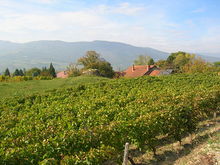Roussette de Savoie

The designation of origin Roussette de Savoie describes a white wine from the Savoie wine-growing region . The designation of origin was named after the Altesse grape variety , which is called Roussette in Savoie . The approved vineyards are distributed among the communes of Apremont , Arbin , Barby , Billième , Le Bourget-du-Lac , Brison-Saint-Innocent , Challes-les-Eaux , Chignin , Chindrieux , Cruet , Francin , Fréterive , Jongieux , Lucey , Les Marches , Montmélian , Motz , Myans , Ruffieux , Saint-Alban-Leysse , Saint-Baldoph , Saint-Germain-la-Chambotte , Saint-Jeoire-Prieuré , Saint-Jean-de-la-Porte , Saint-Jean-de- Chevelu , Saint-Pierre-d'Albigny , Serrières-en-Chautagne and Yenne (all in the Savoie department ) as well as Ayse , Bassy , Bonneville , Challonges , Chaumont , Chessenaz , Clarafond-Arcine , Desingy , Frangy , Franclens , Marignier , Marin , Massongy , Musièges , Publier , Sciez , Thonon-les-Bains , Usinens , Vanzy and Ville-la-Grand (all in the Haute-Savoie department ). The definition of the growing area is almost identical to that of the Vin de Savoie appellation .
In addition to the simple Roussette de Savoie, 4 crus with stricter regulations were recognized:
- Roussette de Savoie Marestel: this cru is only valid for wines from the municipalities of Jongieux and Lucey.
- Roussette de Savoie Frangy: Chaumont, Desingy and Frangy
- Roussette de Savoie Monterminod: Saint-Alban-Leysse.
- Roussette de Savoie Monthoux: Saint-Jean-de-Chevelu.
Since September 4th 1973 the appellation has the status of an Appellation d'Origine Contrôlée (AOC for short).
The vineyards are at an average altitude of approx. 250-560 m above sea level. NN on the slopes of the foothills of the Savoy Alps . Due to the southern orientation of the slopes, the vineyards are protected from the cold north winds. During the night, cool air falls from the heights and ensures a sufficiently high temperature difference between day and night, which is beneficial for viticulture.
Grape varieties
In general, the yields are limited to 59 hectoliters / hectare. Stricter rules apply to the Crus Frangy, Marestel, Monterminod and Monthoux; here the limit is 53 hectoliters / hectare. In its original version, the restriction was only 32 hl / ha and corresponded more to the boundary conditions for producing high quality. Nowadays, due to the success of the wine, there is a tendency to high yields at the upper limit of what is allowed.
The white wine has been made exclusively from Altesse grapes since the 2000 vintage . Before that, Chardonnay up to max. 10% allowed. The straw yellow wines are fruity in nature with an aroma of violets and noticeable notes of honey, almond or hazelnut.
Before fermentation , the natural minimum sugar content of the must must be 153 g / l, which corresponds to an alcohol content of 10 percent by volume in the wine (→ must weight ). For the 4 crus the corresponding values are 162 g / l and 10.5% alcohol by volume. If chaptalization is approved in bad years , the alcohol content of the finished fermented wine must not exceed 13% by volume.
The planting density is at least 5000 vines / hectare.
literature
- Jancis Robinson : The Oxford Wine Lexicon . Gräfe and Unzer Verlag, Munich 2003, ISBN 3-7742-0914-6 .
- Pierre Galet : Cépages et Vignobles de France . Lavoisier Publishing House, Paris 2004, ISBN 2-7430-0585-8 .
- Benoît France: Grand Atlas des Vignobles de France . Éditions SOLAR publishing house, Paris 2002, ISBN 2-263-03242-8 .